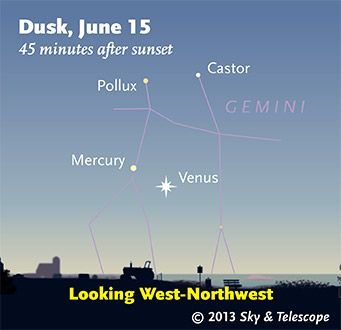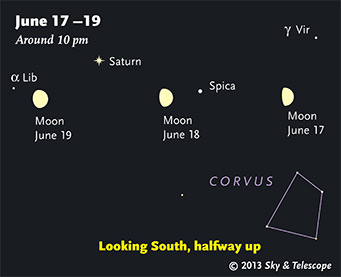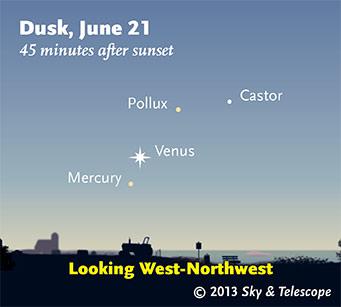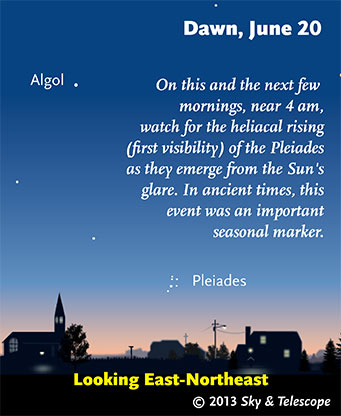
Venus and fading Mercury are drawing closer together.
Friday, June 14
Saturday, June 15
Sunday, June 16

Watch the gibbous Moon pass Spica and Saturn. The Moons here are plotted for the middle of North America. They are three times actual size.
Alan MacRobert
Monday, June 17
Tuesday, June 18
Wednesday, June 19
Thursday, June 20

Mercury is fading and dropping day by day. Use binoculars in bright twilight.
Friday, June 21
Saturday, June 22
Want to become a better amateur astronomer? Learn your way around the constellations. They're the key to locating everything fainter and deeper to hunt with binoculars or a telescope.
For an easy-to-use constellation guide covering the whole evening sky, use the big monthly map in the center of each issue of Sky & Telescope, the essential guide to astronomy. Or download our free Getting Started in Astronomy booklet (which only has bimonthly maps).

The Pocket Sky Atlas plots 30,796 stars to magnitude 7.6 — which may sound like a lot, but that's less than one star in an entire telescopic field of view, on average. By comparison, Sky Atlas 2000.0 plots 81,312 stars to magnitude 8.5, typically one or two stars per telescopic field. Both atlases include many hundreds of deep-sky targets — galaxies, star clusters, and nebulae — to hunt among the stars.
Sky & Telescope
Once you get a telescope, to put it to good use you'll need a detailed, large-scale sky atlas (set of charts). The standards are the little Pocket Sky Atlas, which shows stars to magnitude 7.6; the larger and deeper Sky Atlas 2000.0 (stars to magnitude 8.5); and the even larger Uranometria 2000.0 (stars to magnitude 9.75). And read how to use sky charts with a telescope.
You'll also want a good deep-sky guidebook, such as Sue French's Deep-Sky Wonders collection (which includes its own charts), Sky Atlas 2000.0 Companion by Strong and Sinnott, the bigger Night Sky Observer's Guide by Kepple and Sanner, or the beloved if dated Burnham's Celestial Handbook.
Can a computerized telescope replace charts? Not for beginners, I don't think, and not on mounts and tripods that are less than top-quality mechanically (able to point with better than 0.2° repeatability). As Terence Dickinson and Alan Dyer say in their invaluable Backyard Astronomer's Guide, "A full appreciation of the universe cannot come without developing the skills to find things in the sky and understanding how the sky works. This knowledge comes only by spending time under the stars with star maps in hand."
This Week's Planet Roundup
Venus (magnitude – 3.8) is gaining altitude very gradually, low in evening twilight. Look for it in the west-northwest. Mercury has closed to just 2° or 3° from Venus, but Mercury is fading fast: from magnitude +0.6 on the 15th to +1.6 on the 22nd. Look for it to Venus's upper left (for mid-northern observers) early in the week, directly left around June 16th and 17th, and below Venus by the 20th.
Mars and Jupiter are hidden in the glare of the Sun.
Saturn (magnitude +0.4, in Libra) glows in the south to southwest during evening, with slightly dimmer Spica 12° to its right or lower right. Look almost as far to Saturn's left or lower left for Alpha Librae.
See our telescopic guide "Scrutinizing Saturn" in the May Sky & Telescope, page 50, or the shorter version on our website. And identify Saturn's many moons at any time and date with our SaturnMoons utility or handier app.
Uranus (magnitude 5.9, in Pisces) is in the east just before the beginning of dawn. Neptune (magnitude 7.9, in Aquarius) is in the southeast before dawn. Finder charts for Uranus and Neptune.
All descriptions that relate to your horizon — including the words up, down, right, and left — are written for the world's mid-northern latitudes. Descriptions that also depend on longitude (mainly Moon positions) are for North America. Eastern Daylight Time (EDT) equals Universal Time (also known as UT, UTC, or GMT) minus 4 hours.
Like This Week's Sky at a Glance? Watch our SkyWeek TV short, also playing on PBS.
To be sure to get the current Sky at a Glance, bookmark this URL:
http://SkyandTelescope.com/observing/ataglance?1=1
If pictures fail to load, refresh the page. If they still fail to load, change the 1 at the end of the URL to any other character and try again.
 0
0

Comments
You must be logged in to post a comment.